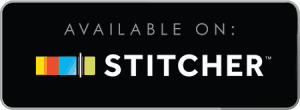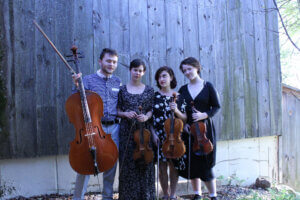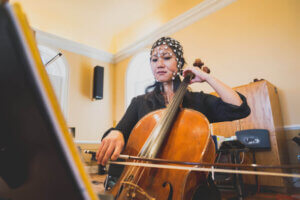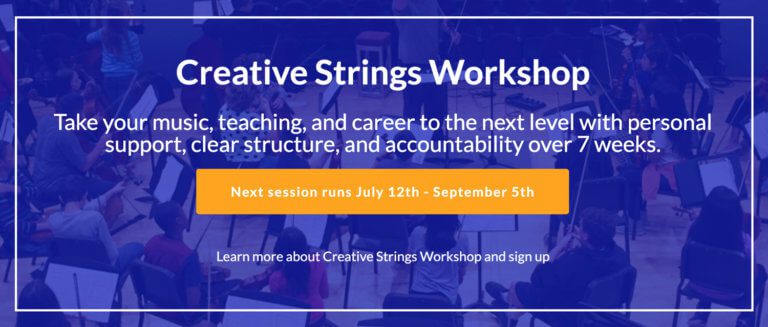On Today’s Episode…
Orchestra Teacher Seth Gamba discuss challenges in Creative Music Education. This interview includes useful tools for teachers, such as Bloom’s Taxonomy in music, and tools for developing creativity in your school string programs and orchestra classroom.
Introduction:
Welcome to our post on teaching creativity in orchestra classrooms! Today, we’ll dive into the experiences and wisdom shared by Seth Gamba. We will discuss how we can foster creativity alongside technical proficiency in our music education practices. Let’s explore these ideas and discover exciting ways to inspire our students to express their musical creativity.
Unleashing Creativity with Bloom’s Taxonomy:
Imagine Bloom’s Taxonomy as a ladder of musical thought, with creativity at the very top. Seth Gamba explains that while many orchestra classrooms primarily focus on the foundational levels of remembering and understanding musical concepts, the ultimate goal is to empower students to create something entirely new and unique. As we climb this ladder, we encourage students to synthesize their knowledge and skills, paving the way for artistic self-expression.
Overcoming Challenges in Fostering Creativity:
Seth Gamba highlights the challenges faced by music teachers when trying to nurture creativity within the traditional repertoire-driven approach. Balancing the need to meet skills targets and the demands of precision in rhythm and tuning can leave little time for creative exploration. Gamba acknowledges that finding ways to incorporate creativity can be a daunting task, but with the right strategies, it is possible.
Benefits of the Play-Along Style:
One approach that Seth Gamba and Christian Howes advocate is the use of play-along videos and exercises. This interactive method engages students in call-and-response activities, allowing teachers to assess their progress quickly. Through play-along, students develop essential skills such as left-hand and right-hand technique, rhythm, intonation, sound production, and projection. Gamba’s unique inclusion of unison worksheets ensures that every student actively participates and develops their listening skills.
The Power of Playing in Unison:
Seth Gamba believes in the power of unison playing to create an engaged and cohesive ensemble. By assigning different parts to various sections, such as bass players learning the first violin parts or violas learning the bass parts, students gain a deeper understanding of the music and improve their listening skills. This approach keeps everyone involved, eliminates waiting time, and promotes a sense of collective musicianship.
Addressing Challenges with Creative Music Education:
To address the challenge of balancing technical skills and creative exploration, Gamba suggests incorporating short, focused activities that integrate multiple skills at once. By dedicating brief periods of time to rhythm, intonation, and play-along sessions, teachers can ensure that students develop a broad range of skills simultaneously. This strategy effectively combines traditional reading-based learning with the valuable experience of learning music by ear.
Embracing Constraints for Creative Exploration:
Christian Howes emphasizes the power of clear constraints and frameworks to unlock creativity. By providing students with specific rhythmic patterns, melodic rhythms, or limited note choices, teachers create a controlled environment for improvisation and composition. These constraints serve as a scaffold for decision-making, empowering students to explore their creative potential within a supportive structure.
Conclusion:
Teaching creativity in orchestra classrooms requires a delicate balance between technical proficiency and artistic exploration. By incorporating these strategies , we can create vibrant learning environments where students thrive. From leveraging Bloom’s Taxonomy to embracing play-alongs, unison playing, and thoughtful constraints, we can nurture the creative spirit in our students. Let’s embark on this exciting journey together and empower our orchestra students to become confident, expressive, and innovative musicians.
If you’re interested in accessing Seth Gamba’s compositions and arrangements, you can find them at JW Pepper, Sheet Music Plus, or reach out to him directly via email at sethgamba@yahoo.com.
Bloom’s Taxonomy in Orchestra
Bloom’s Taxonomy’s first five levels are: remembering, understanding, applying, analyzing, and evaluating are the first five parts of Bloom’s Taxonomy. According to Seth Gamba:
“Bloom’s Taxonomy is a categorization system, for categorizing levels of thought or levels of complexity of thought. So, the most basic level is remembering. Can you recall a fact? What is your name? You can recall that fact. What is the key signature of D Major? Can you recall that fact? The next level is to actually understand something, which is to say, can you put something into your own words? So if I. Name a concept. Can you redescribe that concept to me? And that demonstrates a level of understanding. Can you take the things you know? Can you take the things that you have some understanding of and actually do something with them? We live in the world of instrumental music. We try to live and we live a lot of times in the application stage, right? So if you’re talking about maybe reading music, you see a D note on the staff. Can you recall that that’s a D note? Do you understand that you can play a D note third finger on the A stringing or open D or maybe there are a couple of different ways you can play a D note? Can you apply that? So can you perform music that includes a D note? The next step is to analyze something. And if you are playing music in any kind of self-aware way, there’s constant analysis, tuning, rhythmic precision, and being together with the people around you, there would be pattern recognition. Do you recognize half a scale when you see it? So you’re analyzing as you go, you’re analyzing the way things fit. You’re evaluating all the time, and then all that feeds back into the application. So each one of these levels gets you a little more complicated. But then there’s this creating piece, which is the very top of Bloom’s pyramid, who’s generally presented as a pyramid. Can you take the things you understand and can you put those together in a novel way to make something that’s new? that’s different than what anybody else has done.”
Challenges in Developing Creativity in the Classroom
Seth Gamba points out that music in schools might not be always creative. He claims that music in classrooms is more dedicated to a program and pieces that may be played. In that way, music becomes a recitative art, because the students might give recitals to show their parents what they have learned. And it’s here where the struggles come:
1.- Trying to encourage kids to write music and play their own compositions might be a fantastic project but the time investment is not manageable for a class context.
2.- Start a performance-based class, where students prepare classical scores over the year and present it at different moments of the year. They have to be together, with the correct rhythm, good intonation, the proper dynamics, and with some level of expressiveness.
So it can be said that the most challenging part of developing creativity in the classroom is time management and the number of topics music class should cover.
Benefits of the Play-Along Style in Classroom
The benefit of doing play-along sessions lively with a group of students is that teachers can pretty quickly figure out if students are playing it back to them or not. Then they can decide to maintain the level or low it. After everyone is set, the teacher can gradually make the exercises trickier.
Some of the skills play-along help to develop are:
Left-hand skills and right-hand skills
Rhythm
Intonation
Sound
Projection
Even, Seth Gamba does his own version of the play-along style. With his eighth graders, he practices an improvisation piece where volunteers have some moments to improvise solos. They must play the head together in unison, developing the sense of group and following the teacher’s instructions, but at the same time, they start developing their own improvisational language.
Benefits of playing in unison
Seth Gamba: And, that’s a development, I’ve made over the years. I don’t hand out a piece of repertoire that doesn’t have unison worksheets and I prepare unison worksheets.
So my bass player learns the first violin parts. My violas learn the first violin parts, my first violins learn the bass parts. And we learn everything. Before we go to put together repertoires, it keeps everybody engaged all the time. So I don’t have engagement issues. With my low strings or mid strings. Nobody’s ever waiting and everyone’s developing skills. And then it has the added benefit that when we are putting it together, everyone really knows each other’s posture. So, you get better listening. Because kids know how to listen to each other cuz they know what they’re listening to.
Seth Gamba: And I’d say it just takes me about an hour or so per piece of music to put together that unison worksheet, but that’s my score study. That’s my preparation as a teacher. So I figure that those couple hours on the front end are real-time.
Christian Howes: This would be a value-added thing though. If more teachers, if more composers were writing for educational ensembles. First of all, writing in that way. I heard Bob Phillips talk about this at ASTA. That he always makes sure that he writes melodies for all the instruments. But you’re kind of taking that a step further. That’s great.
Call & Response Play-Along in a Concert
Seth Gamba: So, I’ve been reconceiving what can be a concert program. Because you know what? Parents love to see what their kids are learning. So, if I can give a few of these technique melodies that we’ve all learned in unison, then that gives me a vehicle to communicate with my parents and to educate the audience. And there is no good reason why I couldn’t do a call-and-response demonstration piece as part of a concert. So long as I prepare it, because, you know, we voted back to my perfectionist nature. I want to put kids in a situation where they will be successful, but if I prepare that in class and we’ve done enough of it, I know they can do it.
Christian Howes: I feel like, if you were to start doing call and response, on a regular basis, you would start to get the hang of it, it would be really easy. You know what I mean? So I think probably if you just do it in class, like five minutes a day, and my recommendations for any other teachers that are listening is to have some kind of backing track or metronome or groove machine. Because, we want to keep the kids together, especially if you’re doing syncopations. Now, when I want to get them to improvise responses or even not give them a call and get them to improvise, then there are several strategies that I use, but one of them specifically, that I’ve used in the last couple of days is to give them really clear rhythmic restrictions.
So what I find a lot of times is in the jazz studies canon especially, people will come in and they’ll be like, let me show you this blues scale. Okay? And let me show you this swing rhythm. Let me show you this melody. Let me tell you about the chords. Okay. Now use the blue scale and just play some stuff that, in my experience that does not work. And I see people trying to do it all the time. The reason it doesn’t work is that there’s missing a critical piece of scaffolding. Now, if you were to say give them a specific melodic rhythm, say here are five notes: [humming], G minor Blue Scale, right? And you let them play around with that for a while with calmer senses. But then you say, okay, I want you to use any of those notes, but it’s gotta be this rhythm, [humming]. Then you play. Another constraint and one that they can understand. It makes it so much easier to decide what to do. Because they have a framework to do it in.
Another way that we did that is that I would say, okay, pick any note in the D major scale, but you’re only gonna play on my queue, right? Like, you know, 2, 3, 4, play now – change – change. But again, the critical thing is telling them when to pick the note.
Seth Gamba: Wonder, one of the most common responses you get from kids, is this paralysis of a blank canvas. And it gave it such a great framework. So you have this menu of notes, which is maybe your major scale, but you’ve got four counts and now you’re going to another one that’s, and now you’re going to another and it keeps you moving and, you’re not giving someone this blank canvas, that they get intimidated by. So I thought that was really effective.
Christian Howes: That’s great. Yeah. And then, and I think that even that could be a demonstration, in my opinion. It’s not Call & Response. You can have a loop going. I like to do that with free notes as well, and with these more, nontonal frameworks and stuff. But if you have some kind of rhythm, keep them together. I find that it can really help if it’s a baseline, whatever. And then even if you have kids that are soloing or playing in duos or trios, it can work then too, because let’s say you’ve got just two kids and you say, okay, I want you to make a video in a breakout room or on Zoom or at your house or whatever, but each one of you is just playing free notes, whole notes or one’s playing whole notes and one’s playing half notes and keeping in time.
Challenges with Creative Music Education
Christian Howes: I think it’s great. I love it. I challenge anybody to tell us a reason why that can’t happen rather than teachers listen. Well, let me ask you this if you don’t mind.
Okay. You put down here, what are the challenges we face in doing creative music ed. In other words, teaching kids to go beyond just playing the classical dots. And you said hitting skills targets is a challenge faced in teaching your young music students to be creative.
Why, why is hitting skills targets a challenge? Why is that?
Seth Gamba: The classical symphony orchestra approach is very repertoire centric. In terms of your rhythmic alignment. You gotta have just that precision in your rhythmic alignment in terms of tuning your chords or tuning your unison lines. It just has to be that precise tuning of your unison lines.
Christian Howes: Let me push back on both of those though, because again, you can be honest. But I just worked with your sixth graders and seventh graders and eighth graders. And, my takeaway from that was the kids worked on a lot of rhythms and they also to some degree worked on intonation in all the things we did. I mean, some of it was play-along, and some of it was improv-based.
Seth Gamba: Let’s take the other side of that it’s also the reading. Is the reading, the reading. I’m a reading teacher. I am a language and reading teacher. Some years ago, I completed my teacher certification in reading. So I’m certified in music and reading. And I became a better music teacher by getting certified to teach reading.
Christian Howes: When students have to learn a new piece, teachers make them just keep playing the piece until the concert happens. But I feel like a lot of times people could have learned the basic mechanics of reading the piece. In other ways, for example, let’s listen to a recording and fall along with your music while you’re listening to the recording. For example, let’s play with an actual metronome, let’s do unison work. I would imagine that this would make kids learn stuff faster. And also I would imagine that if you took exercises out of that repertoire that involved them reading, but then had them play other stuff that was slightly by ear or whatever, and then had them come back in the reading that it might reinforce.
Seth Gamba: They might have some level of understanding, some preparation to incorporate play-along sessions, because “You can’t create with something you don’t know”. For example, knowing the difference between G and F sharp, maintaining intonation, and restricting them to some rhythms. If not, you must adjust the level, the language used, and how you approach the kids.
Christian Howes: It can be related to what Daniel Kahneman says in his book “Fast Thinking, slow thinking” book he affirms that we have two modes of thinking. Slow thinking is when we’re learning something, and fast thinking is when we’re already an expert at it. Or it’s instinctual, it’s part of our animal instinct. So if we see a predator we run instantly. But otherwise, if you try to play your violin left-handed, that’s slow thinking, right? If you try to play a game of chess and you haven’t played 200 games, it’s slow thinking.
This is one of the big mistakes in jazz studies. In Jazz studies, the teacher comes and says: Let me show you this blue scale and automatically then: “Okay, now improvise”. But actually, the students don’t know the blue scale yet, they haven’t incorporated it into their language, and they haven’t experimented with it in controlled environments. And that’s the issue with why so many classical musicians try to improvise over chord progressions and they can’t do it because they don’t know the chord progressions deeply enough.”
In solution, we may restrict their options: If we give the student a groove. And then if we give them rhythmic parameters, but allow them to choose free notes, then it can either be chromatic or within a major scale. If we say, here’s the groove and here’s your parameters, you’re gonna play a rhythm, and I want you to do that rhythm, but make up your own notes. Or you’re just gonna move periodically, change the bow, change your note. Now you can play half notes in whole notes. Or you can play half notes, whole notes, and rests.
You can layer those things in and after you start to give them these types of very constrained exercises around improvisational choices, then before you know it, they’re gonna have a lot of freedom. They’re gonna feel free, they’re gonna feel warm, they’re not gonna have a blank slate. And you can be like, okay, right now you can play whatever you want. And they’re gonna go crazy.
When I go to live class, I have these four buckets that I use. One was feelings… (complement here) and I do this thing called free association. I say: “Okay. Play angry”, and all the kids were playing. And I had to stop ’em. I said, now play sad. Then they all played. And then I did confused. All those kids were playing emphatically playing. Every one of your kids was improvising based on just that prompt. They were going all across the neck. They were doing all kinds of things. Then I said, long bows, then I said, bouncing bows, and I said pizzicato. So, in that space that’s practicing a technique. The way I warmed them up was by doing that free association exercise. They were like a game. And so there wasn’t any paralysis. But another way to do it is to have really, really, binary choices. It’s like, play this note or play that note and play at this time. And so I think that also if you give them really clear restraints, you say, okay, I just want you to shift up and down on this string. But you can either slide slowly or fast. That’s it. Go. That will work. And then if you say, now if you were going slow, then go fast now I want you to take some period where you go slow and then some period where you go fast. Then they’re gonna be sliding. You know, you can do a similar thing with them.
Christian Howes: There are some people that say: “kids need to know their foundation before they can improvise before they can be creative” I don’t agree with that either, because I think if you give like a kid who just picked up the instrument, some of that fun, they actually can just play with the instrument if it’s not about doing it right.
You can be creative to an intuitive degree. There’s a famous study, that if you give a kid a toy that does seven different things and you say, here’s this toy, it does these two things and you give it to the kid, the kid will play with the toy, and do those two things. Because a lot of teachers will say, well, people need to learn how to play the instrument first. Before they can get creative.
About Our Guest...

Seth Gamba is an active composer, arranger, and musician dedicated to the world of school music groups. With a passion for composing, his works have earned repeated recognition and prestigious performances at the Georgia Music Educator’s Association state convention. Seth’s expertise extends beyond composition, as he is a highly skilled professional bass player and an advocate for strings education.
Currently serving as an Orchestra director for Fulton County Schools, Seth works tirelessly to nurture the talents of his students. His focus lies primarily on bass students, catering to learners at all levels, utilizing both German and French bows. Additionally, Seth is qualified to teach beginners in violin and viola, guiding them through the foundational stages up to the completion of Suzuki book 3. To further share his knowledge and passion, he offers private lessons through his renowned Gamba Music Studios, located in Roswell, GA.
Seth Gamba obtained his Bachelor’s degree in Double Bass from Indiana University, solidifying his technical and theoretical understanding of the instrument. Continuing his academic pursuits, he pursued a Master of Music Education from the esteemed University of Georgia, enhancing his teaching methodologies and pedagogical expertise.
In addition to his professional commitments, Seth also finds joy in performing a wide range of musical genres, from classical to jazz to hard rock. His versatility as a musician allows him to explore and appreciate various styles, further enriching his teaching and composing endeavors.
Seth Gamba’s dedication to music education, his accomplishments as a composer, and his exceptional skills as a bass player make him an influential figure within the music community. His unwavering commitment to fostering the growth of young musicians and sharing his love for music is truly commendable.












